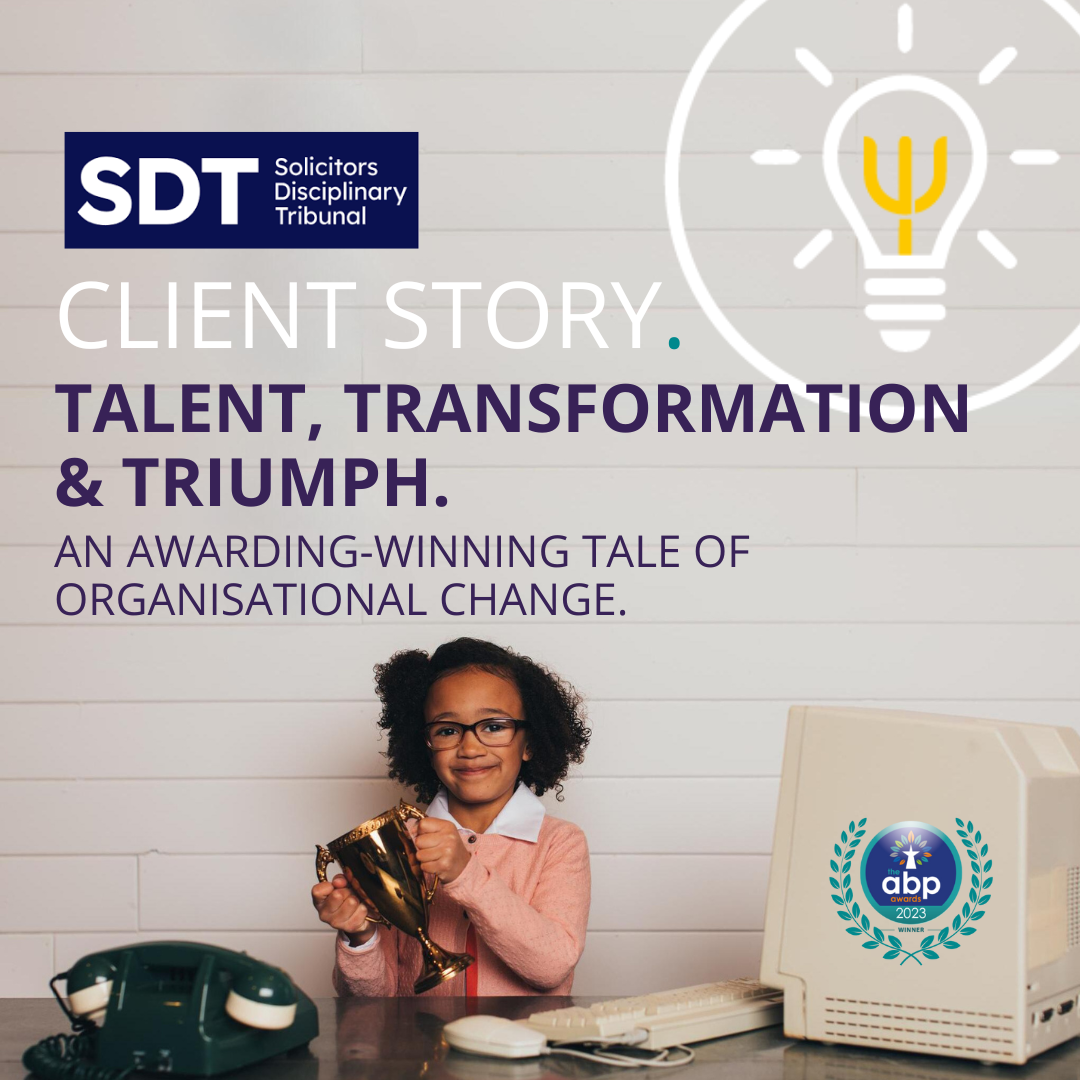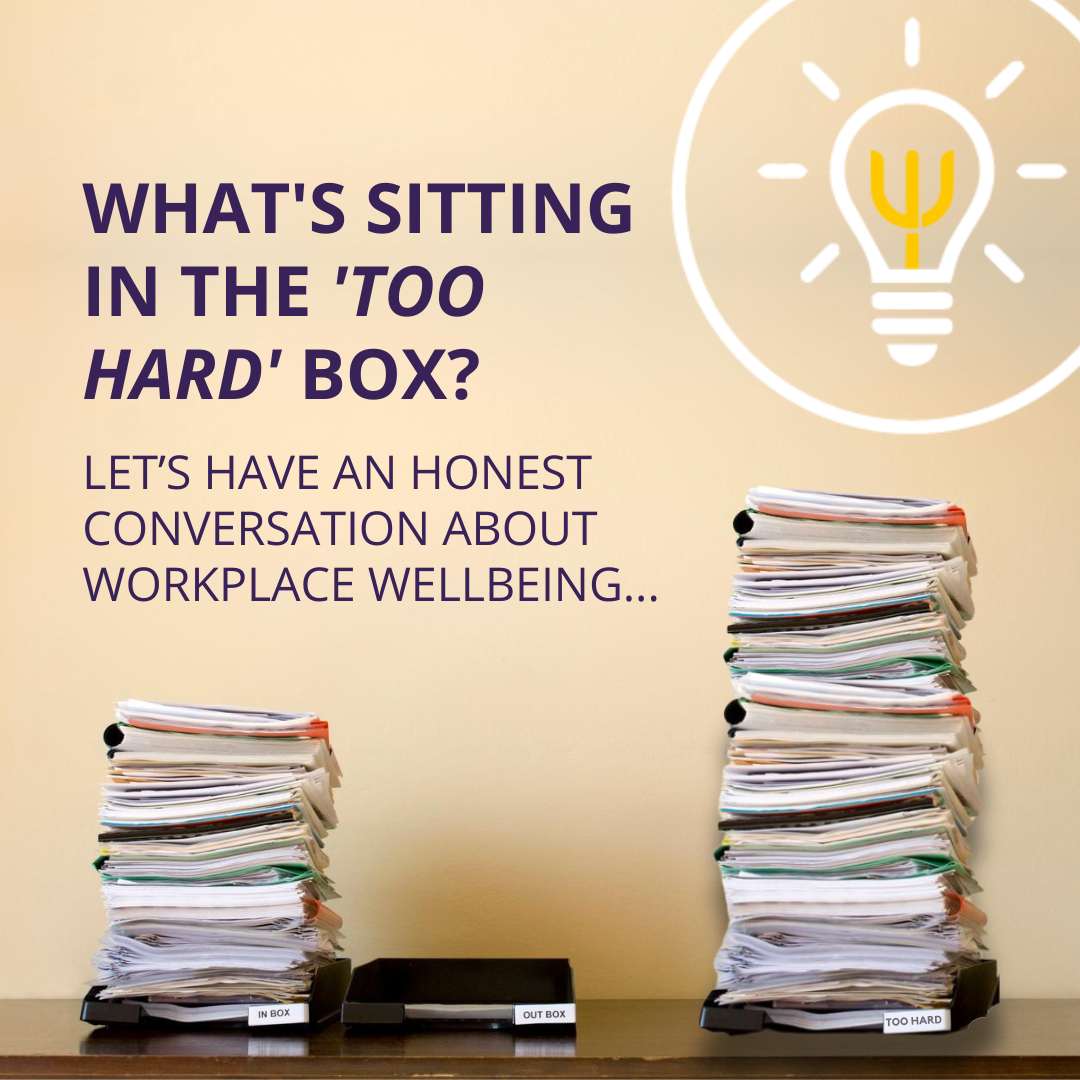What’s sitting in the ‘too hard’ box? Let’s have an honest conversation about Workplace Wellbeing.
“Charlie says we have three boxes: “In,” “Out” and “Too hard.” You don’t have to do everything well. At the Olympics, if you run the 100 meters well, you don’t have to do the shot put…” —
Warren Buffett.
Let's talk about something that's been tucked away in the back of the office closet for far too long: the challenges that often end up in the "too hard" box when it comes to workplace wellbeing.
In the ever-evolving landscape of workplace wellbeing, there are challenges that seem to persistently elude our grasp, landing squarely in the infamous 'too hard' box. As stewards of organisational health, it's imperative that we confront these obstacles head-on, understanding that the wellbeing of employees is not just a goal but a fundamental responsibility.
Also, if we truly want to “put wellbeing at the heart of business… and not just on a mug!” then we can’t just pick and choose, to do one thing and not another. That’s right kiddo, you (unintentionally) signed up for the decathlon not an individual event!
So, it's time to dust off that “too hard” box and shine a light on those niggly, hard to truly get a handle on, issues that may be lurking within…
Mental health support is not easy.
Mental health is the cornerstone of wellbeing, yet tackling it can feel like navigating a labyrinth. The stigma surrounding mental health in the workplace often leaves organisations at a loss for how to provide effective support. But remember, mental health isn't a puzzle to solve alone; it's a journey to embark on together, a partnership between employees and employers.
Physical wellbeing is still a ‘thing’.
Whilst mental health gets a lot of the air time these days, the impact of poor physical wellbeing is still huge. An estimated 35.2 million working days were lost in 2022/23 due to self-reported work-related ill health or injury (HSE, 2023). In reality, workplace health and safety is just the tip of the iceberg when it comes to physical wellbeing. Providing ergonomic workspaces and promoting healthy lifestyles requires a holistic approach – especially when workspaces are no longer just about a traditional office environment. Think of it as laying the foundation for a sturdy house; without it, the entire structure is at risk of collapse.
Work-Life balance is still ‘unbalanced’ for nearly everyone.
Achieving that elusive work-life balance can sometimes feel like trying to catch a unicorn. Demanding schedules and cultural norms may make it seem out of reach. However, with deliberate effort, open dialogue, a commitment to establishing clear boundaries and prioritising the personal lives of employees, it is possible to creating policies and cultures that promote balance.
The Equity, Diversity, Inclusion & Belonging angle.
Building a truly inclusive workplace is akin to tending to a garden; it requires nurturing, patience, and a keen eye for rooting out systemic biases. Addressing diversity and inclusion isn't just about ticking boxes; it's about embracing the richness of human experience and creating environments where everyone feels seen, heard, and valued. Whilst, a truly important issue all on its one, the connection with wellbeing cannot be ignored or the two issues addressed in silos.
Employee engagement and satisfaction (in action, not just in a survey)
Keeping employees engaged and satisfied isn't a one-time task; it's a perpetual journey – which just start and end with sending out a survey! Fostering a positive work environment, providing meaningful opportunities for growth, and addressing issues head-on are all essential steps. After all, engaged employees are the lifeblood of any organisation. However, we also know that implementing the issues that get often get flagged in these survey’s don’t lend themselves to ‘quick wins’, but instead can require more systemic change.
The hybrid/remote work/return to work challenge.
The shift to remote and hybrid work brought its own set of challenges, from maintaining communication to combating feelings of isolation. Figuring out when, how or even if to mandate a return to the office in a way that treats everyone like grown ups has take the challenge to the next level. But with the right tools and approach, remote work can create opportunities to foster even stronger connections and promote flexibility, not to mention providing a more attractive employer brand.
Financial wellbeing.
Post-Covid, financial wellbeing is longer the elephant in the room, but navigating what you can do as an employer can at times be confusing. Providing resources for financial literacy and support can alleviate stress and empower employees to take control of their financial futures, is good - helping an exec team see the benefit of paying a real living wage - so your employees are less likely to need financial wellbeing support in the first place - is better but infinitely harder.
Burnout prevention.
Burnout is the silent assassin of productivity and morale. It's not an insurmountable foe, but you can’t fix it with a resilience workshop or free counselling via a 5* Employee Assistance Programme (EAP). It takes honestly addressing resourcing and workload management, setting realistic expectations, and fostering a culture of support and autonomy to prevent burnout before it takes hold. An quick and easy fix, this one is not!
Managers.
Managers are the linchpins of employee wellbeing, yet they often lack the resources they need to fully shoulder this responsibility. A lot of them are also as frazzled and worn out as everyone else - but with added responsibility. Providing them with the tools, guidance and support – so they in turn can support their teams, is essential for creating a culture of care and accountability.
Addressing Causes, Not Just Symptoms
It's easy to get caught up in treating the symptoms of workplace wellbeing issues, but addressing the root causes requires a deeper commitment from the business. By identifying and dismantling systemic barriers, we can create environments where everyone can thrive, which brings us to…
Organisational Culture
Cultivating a healthy organisational culture is a marathon, not a sprint. It requires introspection, courage, and a willingness to challenge the status quo. But the rewards—increased productivity, higher morale, and a stronger sense of belonging—are well worth the effort. If only it was easier!
Gaining Senior Stakeholder Buy-in
Support for workplace wellbeing initiatives from senior stakeholders is absolutely crucial. However, this endeavour can prove arduous, particularly when short-term financial objectives or challenges can overshadow longer-term wellbeing outcomes. Looking to them to role model the healthy behaviours that reflect the organisational culture can be an even greater challenge! And finally, let’s not forget….
HR is as frazzled and worn out as everyone else!
Let’s call it out. Right now HR is playing an absolutely critical role in ensuring that wellbeing is treated as a serious business issue, relentlessly driving through policies and initiatives to move the needle forward and keep it on the agenda. But constantly putting the needs of others first can mean we, and our HR colleagues, often neglect our own health and wellbeing, at the expense of advocating for that of others.
Final thoughts…
This is list is likely not exhaustive, and we might have missed a few off - especially as the exact combination as challenges will be unique to every organisation. However, we hope that reading this list has proved somewhat cathartic! We also know, that the first step in tackling a tricky challenge is calling it out in the first place.
The harsh reality is that as leaders and advocates for workplace wellbeing, it's our duty to confront the 'too hard' box head-on. But we have empathy, compassion, determination, and a willingness to learn and grow, as our super powers - and in navigating these challenges, we are not alone. As the old adage goes: “We are stronger together than we are alone.”
Find out more…
If you would like to know more about how Psychology Works could help you with the stuff sitting in your workplace wellbeing “Too Hard” box, just give us a shout! On 01273 569314 or hello@psychologyworks.global.
How Psychology Works have helped organisations to get a grip on what was sitting in their ‘too hard’ box…
Client Story: Talent, transformation and triumph. An awarding-winning tale of organisational change at the SDT.
Encore…
In the meantime, if you’ve enjoyed Maria’s ramblings why not check out some of our other blogs and thought pieces. For real time updates and insights you can also find us on LinkedIn, our social media platform of choice: @PsychologyWorks and @mariagardner
























